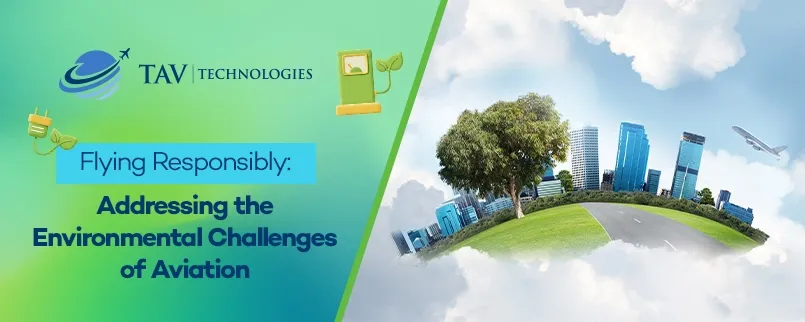
Apr 2024
In the contemporary era, aviation serves as a crucial mechanism for connecting people and transporting goods across extensive distances swiftly. However, alongside this convenience, there exists a substantial environmental toll. As professionals within the aviation technology sector, it's crucial to comprehend and address the environmental challenges confronting the industry. In this blog, we'll explore these challenges, supported by statistical insights, and explore potential strategies to mitigate their impact.
Carbon Footprint: The aviation industry stands as a notable contributor to global carbon emissions, accounting for approximately 2-3% of total CO2 emissions worldwide according to IATA. Commercial flights are the primary source of these emissions, with a single round-trip flight from New York to London producing as much CO2 as the average person emits from driving a car for an entire year. This statistic underscores the urgent need for the adoption of sustainable practices within the aviation sector.
Noise Pollution: Despite being frequently overlooked; noise pollution represents a significant environmental concern associated with aviation. The sound of jet engines and air traffic can have adverse effects on both human health and wildlife. Studies indicate that exposure to aircraft noise can lead to increased stress levels, sleep disturbances, and cardiovascular issues. Around 20% of Europeans are exposed to noise levels deemed harmful to health by the European Environment Agency (EEA), emphasizing the need for effective noise reduction measures.
Air Quality: In addition to CO2 emissions, aircraft engines release various pollutants such as nitrogen oxides (NOx), sulfur oxides (SOx), and particulate matter (PM). According to a study conducted by the European Aviation Safety Agency (EASA), these emissions significantly contribute to air pollution, particularly near airports. Research published in the journal Environmental Science & Technology highlights that airports located in densely populated urban regions experience elevated levels of air pollution, with increased concentrations of nitrogen oxides and particulate matter. Furthermore, the World Health Organization (WHO) has found that exposure to aviation-related pollutants is associated with respiratory illnesses such as asthma and an increased risk of cardiovascular disease, particularly among communities living near airports.
Land Use and Habitat Destruction: The expansion of airports and associated infrastructure frequently necessitates land use changes and habitat destruction, particularly in ecologically sensitive areas. Wetlands, forests, and other natural habitats are often cleared to accommodate runway extensions, terminal buildings, and parking facilities. According to International Civil Aviation Organization (ICAO), there are strong links between climate change, biodiversity loss and economic prosperity, which leads to changing business approaches in order to increase protection of natural capital, including the ecosystems as a provider of essential goods and services This loss of biodiversity can have far-reaching ecological consequences, disrupting local ecosystems and threatening wildlife populations.
Waste Generation: The aviation industry generates substantial amounts of waste, including plastic cups, food packaging, and other disposable items used during flights. Additionally, aircraft maintenance activities produce hazardous waste such as hydraulic fluids, lubricants, and de-icing fluids. According to a report by the International Air Transport Association (IATA), the aviation industry generated over 6 million tons of cabin waste in 2019 alone, with only a fraction of it being recycled. While efforts have been made to reduce waste through recycling and waste minimization programs, further sustainable practices are necessary to address this ongoing issue.
Towards Sustainable Skies - A Call to Action
Addressing these environmental challenges requires a collective effort involving technological innovation, regulatory interventions, and industry collaboration. For instance, the development of more fuel-efficient aircraft designs has the potential to significantly reduce carbon emissions. According to a report by the International Civil Aviation Organization (ICAO), improvements in aircraft fuel efficiency have resulted in a 2% annual reduction in fuel consumption per passenger kilometer since 2009. Furthermore, the implementation of effective emission standards, such as those outlined in the Carbon Offsetting and Reduction Scheme for International Aviation (CORSIA), is essential for curbing greenhouse gas emissions from aviation. Additionally, promoting the use of alternative fuels, such as (SAFs), can help reduce the industry's reliance on fossil fuels. It's imperative that stakeholders within the aviation industry prioritize sustainability and strive to minimize their ecological footprint. By raising awareness of these environmental challenges and advocating for responsible stewardship of our planet's resources, we can pave the way for a more sustainable aviation sector that benefits both humanity and the environment.
